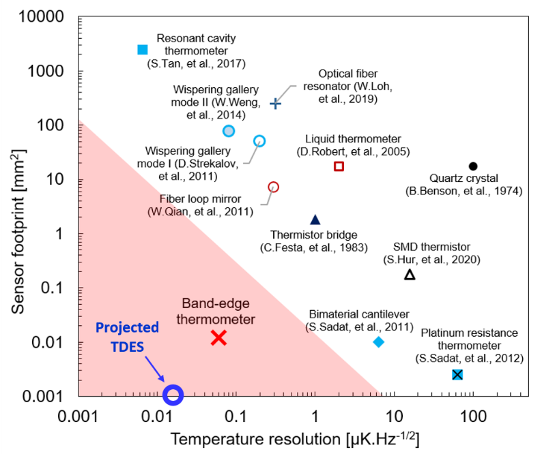
High-resolution room-temperature thermometers described in the literature as a function of their resolution and footprint area. Highlighted area shows microscale and nanokelvin resolution. The projected resolution and footprint of the proposed Tunneling-Diffusion Edge Sensor (TDES) are marked in blue.
Invention Summary:
Ultrahigh-resolution thermometry is critical for future advances in bio-calorimetry, bolometry for sensing and imaging in infrared and terahertz (THz) range, as well as thermal metrology for electronic, optoelectronic and quantum devices.
Rutgers researchers have significantly improved their previously developed technology, called Band-Edge Thermometer (BET), by developing a new sensor called a Tunneling-Diffusion Edge Sensor (TDES). The invention consists of a semiconductor tunneling diode structure, where an electrical current is passed because of quantum tunneling of charge across the barrier when a bias is applied across the device. The current-voltage characteristic of tunneling diodes is temperature-dependent because of the temperature-dependent band structure and carrier population in the semiconductor layers. Therefore, the resistance of the tunnel diode at the sharp negative differential resistance region provides a very sensitive signal for temperature measurement, which would theoretically allow nanokelvin-resolution thermometry with microscale footprint at room temperature.
Market Applications:
- TDES can improve sensitivity and resolution of existing calorimeters and bolometers by 1-3 orders of magnitude.
- TDES can used for probing chemical reactions, metabolism in single cells and biological systems, metrology of electronic and quantum systems, millimeter-wave/terahertz detection, thermal imaging and communication technology.
Advantages:
- Compatible with commercially available microfabrication techniques and can be integrated on a microscale and nanoscale footprint.
- Ultra-high temperature resolution outperforming all other sensors with similar dimensions by 2-3 orders of magnitude.
- Electronic readout compatible with standard analog electronics which are both cost-effective, compact, and easy to integrate with other electronic components
- Regarding uncooled microbolometers for thermal imaging, the proposed technology offers a 100-fold improvement in temperature coefficient of resistance of the sensing element, significantly reducing the noise floor for detection leading to enhanced sensitivity (i.e. enhanced noise equivalent temperature difference, NETD).
Intellectual Property & Development Status: Provisional patent application filed, patent pending. Available for licensing and/or research collaboration. For any business development and other collaborative partnerships contact marketingbd@research.rutgers.edu.